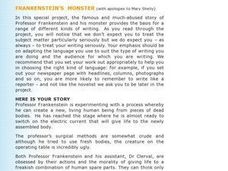Curated OER
Sedimentary Size and Structures
Middle schoolers interpret the Earth's history from models. In this investigative lesson plan students create sedimentary deposit models.
Curated OER
Types of Trains
Third graders explore different types of trains. In this science lesson, 3rd graders study the "Orphan Train" and write a paragraph about what it would feel like to be riding a train during this time period.
Curated OER
Magnets 2: How Strong is Your Magnet?
Students work together to test the strengths of various types of magnets. After testing, they create a graph showing how the strength changes as the distance from the magnet increases. They discuss how forces can act from various...
Curated OER
Magnets 1: Magnetic Pick-ups
Students are introduced to the power of magnets. In groups, they look at different objects and make predictions on whether they believe they are magnetic or not. They test their predictions and share their results with the class.
Curated OER
Water and Ice
Students examine the relationship between water and ice. In this physics lesson, students read the book Amazing Water and participate in an experiment where they freeze water into ice cubes. Students observe the changes in the water when...
Curated OER
Human Activity and the Environment 2004
Learners brainstorm the ways we use energy sources in our daily lives and what our lives would be like without it. They answer questions based on sections from the Human Activity and the Environment 2004, "Energy in Canada" article.
Curated OER
Making A Compass
This interesting science instructional activity is about the compass. Students make a compass out of a magnet, sewing needle, cork, and a glass dish. The instructional activity includes both a pre and post-test for the students to take,...
Curated OER
Transistor Hunt
Learners locate transistor devices in school. They explain the importance of transistors.
Curated OER
How is the Strength of an Acid Determined?
Young scholars study acids and how they can be measured. In this acid lesson students distinguish the properties that create strong and weak electrolytes.
Curated OER
Making Lightening: In Your Mouth
Learners look at a lightening demonstration. In this lightening instructional activity, students bite into a wintergreen candy while looking in the mirror in a dark room. They see sparks in their mouths if they perform the task correctly.
Curated OER
Electrophoresis Analogy
High schoolers participate in a simulation of electrophoresis separation of DNA fragments. They link arms to form DNA fragments with each student representing a nucleotide. As they move through an obstacle course they discover how...
Curated OER
Exploring Magnetic Fields
Students develop the concept that magnets attract and repel items and exert a magnetic field that can vary in strength.
Curated OER
What are Conductors and Insulators?
Students explore simple circuits. Students conduct a variety of experiments to discover their level of conductivity. Students summarize and explain experimental findings. Students are introduced to passive causality.
Curated OER
Teaching Avogadro's Number
High schoolers design an experiment to determine Avogadro's number. Students utilize an ammeter, an electrolytic cell and internet research.
Curated OER
Red Shift, Blue Shift
Pupils demonstrate how stellar spectra measures a star's motion relative to Earth along the line of sight.
Curated OER
Deposition
Students follow carefully designed instructions to bond silver to glass thus creating a mirror. The process used, Brashear's Process, uses sugar rather than formaldehyde to reduce the compounds, but many of the chemicals are dangerous,...
Curated OER
DNA Sequencing Simulation
Young scholars simulate the Sanger method of DNA sequencing using color pop-beads as a representation of nucleotides and dideoxynucleotides. Students assemble DNA sequences and run their sequences through a "sequencing gel" and sketch...
Curated OER
Frankenstein's Monster
Students read Mary Shelly's Frankenstein. Using situation and question prompts, students write various essays, letters, and articles concerning the events in the story from different character's point of view.
Curated OER
DNA Fingerprinting with Gel Electrophoresis
Students use DNA fingerprinting to demonstrate the concept that DNA fingerprinting can be used to identify individuals and solve problems. They use gel electrophoresis to analyze the DNA of a suspected criminal to prove innocence or guilt.
Curated OER
Applied Science - Built Environment Pre Lab (Morse Code)
Students study communication. In this telegraph lesson, students examine Morse code and the composition of an elementary telegraph circuit. They listen to a presentation and try to create Morse Code messages on a worksheet. This lesson...
Curated OER
Conductors and Insulators
Fifth graders explore conductors and insulators. In this science lesson, 5th graders act as electrons moving through a wire. Students break into groups representing conductors and insulators and explore how they work with electrons.
Carnegie Mellon University
Nuclear Energy
Extensive background material, clear objectives, and more are provided to help you teach an introduction to nuclear power. Learners will be able to explain how nuclear power is generated and how it compares to coal-created power. Provide...
Curated OER
Industry Based Learning
High schoolers engage in a series of experiences based upon helping them become associated with industry. They participate in work experience based activities in order to create a context for future career choice. Students also complete...
Curated OER
Wavelengths of Light
Explore physical science by participating in a visual spectrum experiments. Budding scientists identify the colors in the color spectrum and view the colors in class by utilizing cellophane, flash lights, and other arts and crafts...
Other popular searches
- Current Electricity
- Static and Current Electricity
- Bill Nye Current Electricity
- Current Electricity Test
- Current Electricity Power
- Current Electricity Review
- Static or Current Electricity
- Statc or Current Electricity
- Static Electricity Current

























